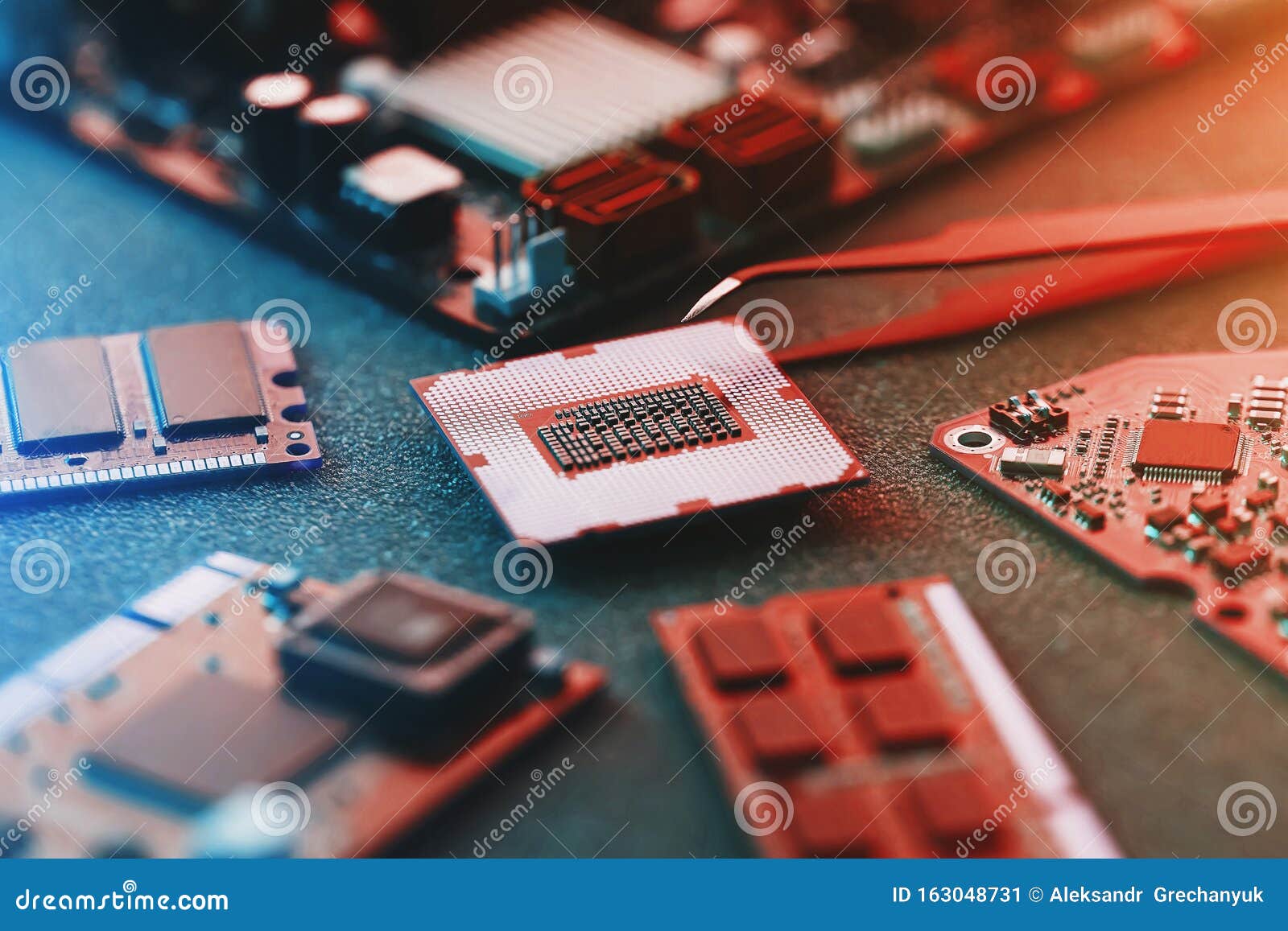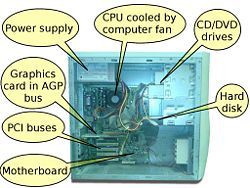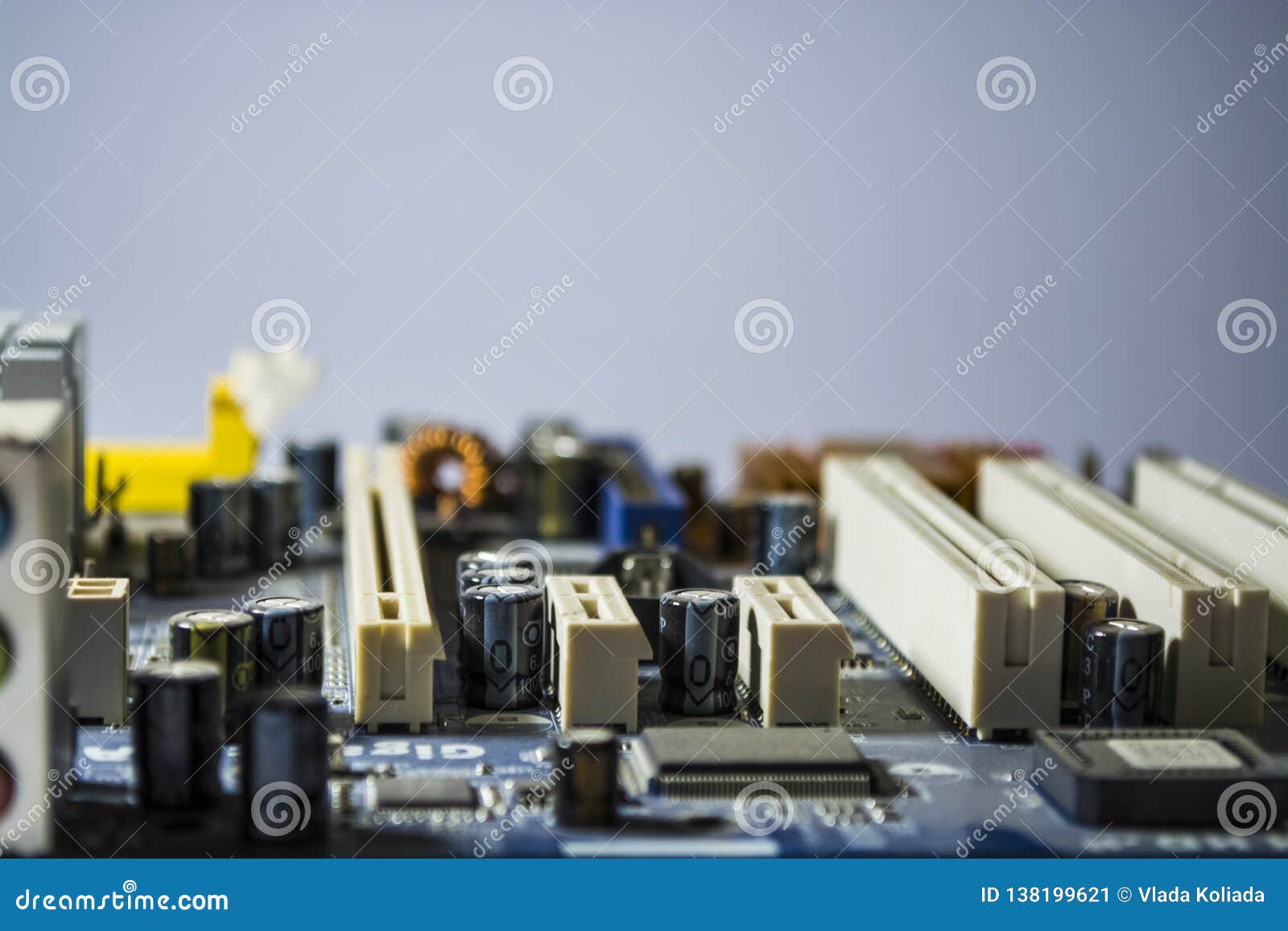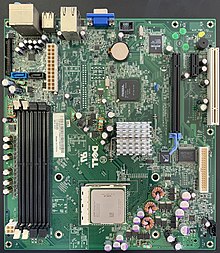The computer motherboard is the main printed circuit board (PCB) where most computer components are connected. It provides connectivity between the computer hardware components, for instance, the processor(CPU), memory (RAM), hard drive, and video card. The motherboard is also known as System Board, Mainboard, Mobo, Main Circuit Board, Planar Board, Logic Board, and Printed Wired Board (PWB) among other names.
It is located at the bottom or on the side of the computer chassis depending on the type of desktop computer you have. The motherboard has many printed wires that carry power and data signals between one component and the other. It connects directly or indirectly to every part of the Personal Computer. The type of motherboard installed in a PC has a great effect on system speed and future expansion capabilities.
The motherboard is the piece of computer hardware that can be thought of as the 'backbone' of the PC, or more appropriately as the 'mother' that holds all the pieces together. Phones, tablets and other small devices have motherboards, too, but they're often called logic boards instead. Comprehensive solution: Performs an automated 229-point full service computer diagnostic exam. Independent lab proven: Multiple 3rd party experts prove System Mechanic works hard to improve PC speed and reliability. Science-driven power: Uses iolo Labs’ research data to automatically fix over 36,000 different types of problems and errors. In other words, a motherboard can also be defined as the basic building block of a computer. As you might know, a standard laptop or a desktop computer is made up of different things such as the. Here is a diagram of major ports, headers, and slots common on today’s motherboards, plus a guide to expansion slots, RAM and form factors.
What Is a Computer Motherboard Made Of?
Amotherboard is mainly composed of two materials:
- Layers of fiberglass for the purpose of insulation.
- Copper toform conductive pathways.
Computer Motherboard Components
The motherboard holds all the major components of the computer. These motherboard components include:
- The processor (CPU)
- CPU socket
- Main Memory (RAM)
- Memory slot
- Math Co-Processor
- BIOS
- CMOS memory
- CMOS Battery
- Expansion slots
- Cache memory
- CPU Clock
- I/O ports
- Hard disk controllers
- SATA connector
- Super I/O chip
Central Processing Unit or the CPU
Also known as the microprocessor, the CPU is the brain of the computer. It fetches, decodes and executes program instructions as well as performing mathematical and logical calculations. The processor is one of the most important computer motherboard components.
The CPU chip is identified by the processor type and the manufacturer. This information is usually inscribed on the processor chip, for instance, Intel 386, Advanced Micro Devices (AMD) 386, Cyrix 486, Pentium MMX, Intel Core 2Duo, Intel Core i7, among others. The processor fits into the processor socket.
Processor Socket
A CPU socket or processor socket is a connection that allows a computer microprocessor to be inserted on the motherboard. There are various types of processor sockets depending on the CPU being inserted. You can identify the processor socket as socket 1 to Socket 8, LGA 775, Socket A, Socket F, among others.
Main Memory (RAM)
The Main Memory, Primary Memory, System Memory or Random Access Memory (RAM), refers to the physical memory of the computer. The word main is used to distinguish it from external mass storage devices such as disk drives. The memory is the working place of a computer. It is a hardware device that stores data for easy retrieval. It is volatile meaning it holds data as long as there is power. Once the power goes off or the computer is turned off, all the contents in RAM are lost.
The computer can manipulate only data that is in the main memory. Therefore, every program you execute and every file you access must be copied from a storage device into main memory. The amount of main memory on a computer is crucial. This is because it determines how many programs can be executed at once and how much data can be readily available to a program.
Types of RAM
There are two broad categories of RAM. These are SRAM and DRAM.
Memory Slot
It is also known as amemory socket or RAM slot. This is the slot or connection point where RAM modules are inserted on the motherboard. There may be two or four RAM slots depending on the motherboard in use.
Math Coprocessor
The Math coprocessor is a type of microprocessor that is optimized to execute complex mathematical calculations e.g. irrational numbers and arrays. It was an optional add-on for earlier Intel processors such as 8086, 80386 and 80486. This allowed computers to perform mathematical calculations faster. It is also referred to as a numeric coprocessor or a floating-point coprocessor. Modern computer processors come with an integrated math coprocessor.
The 486DX processor was the first processor to include an in-built math co-processor (inside the CPU). The earlier processors 8088, 8086, 80286, 80386SX & DX, and 486SX had their math co-processors on the motherboard.
Basic Input Output System – BIOS
BIOS is a term that stands for basicinput/output system. It consistsof low-level software that controls the system hardware and acts as aninterface between the operating system and the hardware. BIOS is used by themicroprocessor to get the computer started after it is turned on.
All motherboards include a small block of Read
The BIOS is stored on a ROM chip because ROM retains information even when no power is being supplied to the computer. The downside of storing data in an older computer’s ROM is that the chip has to be removed to update information. Many modern PCs have flash BIOS, which means that the BIOS has been recorded on a flash memory chip, which can be updated if necessary.
The BIOS is typically placed in a ROM chip thatcomes with the computer (it is often called a ROM BIOS). This ensuresthat the BIOS will always be available and will not be damaged by diskfailures. It also makes it possible for a computer to boot itself. Because RAMis faster than ROM, though, many computer manufacturers design systems so thatthe BIOS is copied from ROM to RAM each time the computer is booted. This isknown as shadowing.
The PC BIOS is fairly standardized, so all PCsare similar at this level (although there are different BIOS versions).
Some Bios Hardware Configuration Options That Can Be Changed
- Change the Boot Order
- Load BIOS Setup Defaults
- Remove a BIOS Password
- Create a BIOS Password
- You can change the Date and Time
- Change Floppy Drive Settings
- To change Hard Drive Settings
- Changing CD/DVD/BD Drive Settings
- View Amount of Memory Installed
- Change the Boot Up NumLock Status
- Enable or Disable the Computer Logo
- Enable or Disable the Quick Power-On Self-Test (POST)
Unified Extensible Firmware Interface(UEFI)
Thisis a specification for a software program that connects a computer’s firmwareto its operating system. It is expected to replace BIOS.
UEFI is installed at the time of manufacturing and just like BIOS; it is the first program that runs when a computer is powered on. UEFI checks for the hardware components installed on the computer. It wakes the available devices and hands them over to the operating system. It is programmable and hence developers can add applications and drivers. This makes UEFI function as a lightweight operating system. It is managed by a group of chipset, system, hardware, firmware, and operating system vendors called the UEFI Forum.
Advantagesof UEFI
- It comes with a user
– friendly, graphical user interface. - It recognizes large storage drives over two terabytes.
- UEFI can support remote diagnostics and repair of computers, even with no operating system installed.
- You can use a mouse in the interface
- It comes with a
secure boot feature
Complementary Metal Oxide Semiconductor – CMOS

Motherboards also include a small separate block of memory made from CMOS RAM chips. Other names of the CMOS are RTC (real-time clock), NVRAM (non-volatile RAM) or CMOS RAM. It stores information about the BIOS settings. The CMOS RAM is kept alive by the CMOS battery even when the PC’s power is off. This prevents reconfiguration when the PC is powered on. CMOS devices require very little power to operate.
The CMOS RAM is used to store basic information about the PC’s configuration. For instance;
- Floppy disk and hard disk drive types
- CPU
- RAM size
- Date and time
- Serial and parallel port information
- Plug and Play information
- Power Saving settings
The other important data kept in CMOS memory is the time and date, which is updated by a Real
Cache Memory
It is a small block of high-speed memory (RAM) that enhances PC performance by pre-loading information from the main memory (relatively slow) and passing it to the processor on demand.
Most CPU
ExpansionBuses
An expansion bus is an assortment of wires that allows for computer expansion with the use of an expansion board. Expansion buses give rise to expansion slots. Expansion boards are inserted into an expansion slot on the motherboard or backplane that provides additional features to a computer system. Buses carry signals, such as data; memory addresses, power and control signals from component to component.
Expansion buses enhance the PCs capabilities by allowing users to add missing features in their computers in the form of adapter cards that are slotted in expansion slots. The different types of buses include PCI, ISA, EISA I/0 bus.
Expansion Slots
Alternatively referred to as a bus slot or expansion port, an expansion slot is a connection or port located on the motherboard. It is where an expansion card is inserted.
Chipset
A chipset is a group of smallcircuits that coordinates the flow of data and instructions betweenthe central processing unit (CPU) or microprocessor and external devices. Thisincludes the CPU itself, the main memory, the secondary cache and any devicessituated on the buses. The chipset also controls data flow to and from harddisks, and other devices connected to the IDE channels.
Chipset manufacturers include Intel, UMC, SIS, VIA, ALI, OPTI,
- The NorthBridge (also called the memory controller) is in charge of controlling transfers between the processor and the RAM. That is why it is located physically near the processor. It is sometimes called the GMCH, for Graphic and Memory Controller Hub.
- The SouthBridge (also called the input/output controller or expansion controller) handles communications between peripheral devices. It is also called the ICH (I/O Controller Hub). The term bridge is generally used todesignate a component which connects two buses.
CPU Clock
The CPU clock is an internal timing device that breatheslife into the microprocessor by feeding it a constant flow of pulses. Forexample, a 400 MHz CPU receives 400 million pulses per second from the clock. A2 GHz CPU gets two billion pulses per second. The clock synchronizes theoperation of all parts of the computer and provides the basic timing signal forthe CPU. Similarly, in a communications device, a clock may be used tosynchronize the data pulses between sender and receiver.
Switches
DIP (Dual In-line Package)switches are small electronic switches found on the circuit board that can beturned on or off just like a normal switch. They are very small and so areusually flipped with a pointed object such as a screwdriver, bent paper clip orpen top. Care should be taken when cleaning near DIP switches as some solventsmay destroy them. They are usually used to make or break a connection within acircuit.
Jumper Pins
Jumpers are small pins on theboard with plastic or metal devices that go over the pins. This device iscalled a bridge. When the bridge is connected to any two pins via a shortinglink, it completes the circuit and a certain configuration has been achieved.
Circuit Board Jumper Caps/ Shunts
A jumper cap is a metal connector that closes an electrical circuit. Typically, a jumper consists of metal connector encased with a plastic covering. They are designed to fit over a pair of protruding pins. Jumpers are sometimes used to configure expansion boards. By placing a jumper plug over a different set of pins, you can change a board’s parameters.
3-Pin Case Fan Connectors
These pins are for connecting the case fan also known as the system fan. The system fan is used to bring in cool air and blow out hot air from the system unit. This helps cool the computer motherboard components.
Heat Sink
A heat sink is a device made of an aluminium finned radiator used to absorb excessive or unwanted heat from some computer motherboard components. There are two types of heat sinks, active and passive heat sink. Passive heat sinks have no mechanical components, just the aluminium finned radiator material. On the other hand, active heat sinks utilize the computer’s power and may come with a fan mounted on top.
24-Pin ATX Power Supply Connector
This is where you connect the ATX power supply on the motherboard. The corresponding connector has a small clip on the top that snaps to hold the connector in place. The connector is keyed to ensure it connects in one direction.

SATA Connectors
This is the connection point for mass storage devices such as hard disk drives, optical drives, and solid-state drives. Serial ATA succeeded the earlier IDE connectors that used Parallel ATA (PATA) standard to become the predominant interface for storage devices.
Super IO Chip
This type of controller is an integrated circuit found on the computer motherboard. It handles the slower and less prominent input/output devices such as floppy disk controller, game port, parallel port, real-time clock, and serial port UART among others.
Well,those are just some of the computer motherboard components. You will findothers not discussed here because we have different types of motherboarddesigns.


A mechanical computer is built from mechanical components such as levers and gears, rather than electronic components. The most common examples are adding machines and mechanical counters, which use the turning of gears to increment output displays. More complex examples could carry out multiplication and division—Friden used a moving head which paused at each column—and even differential analysis. One model[which?] sold in the 1960s calculated square roots.
Mechanical computers can be either analog, using smooth mechanisms such as curved plates or slide rules for computations; or digital, which use gears.
Mechanical computers reached their zenith during World War II, when they formed the basis of complex bombsights including the Norden, as well as the similar devices for ship computations such as the US Torpedo Data Computer or British Admiralty Fire Control Table. Noteworthy are mechanical flight instruments for early spacecraft, which provided their computed output not in the form of digits, but through the displacements of indicator surfaces. From Yuri Gagarin's first manned spaceflight until 2002, every manned Soviet and Russian spacecraft Vostok, Voskhod and Soyuz was equipped with a Globus instrument showing the apparent movement of the Earth under the spacecraft through the displacement of a miniature terrestrial globe, plus latitude and longitude indicators.
Mechanical computers continued to be used into the 1960s, but were quickly replaced by electronic calculators, which—with cathode-ray tube output—emerged in the mid-1960s. The evolution culminated in the 1970s with the introduction of inexpensive handheld electronic calculators. The use of mechanical computers declined in the 1970s and was rare by the 1980s.
In 2016, NASA announced that its Automaton Rover for Extreme Environments program would use a mechanical computer to operate in the harsh environmental conditions found on Venus.[1]

Examples[edit]
- Antikythera mechanism, c. 100 BC – A mechanical astronomical clock.
- Cosmic Engine, 1092 – Su Song's hydro-mechanicalastronomicalclock tower invented during the Song dynasty, which featured the use of an early escapement mechanism applied to clockwork.[2][3][4][5]
- Castle clock, 1206 – Al-Jazari's castle clock, a hydropowered mechanical astronomical clock, was the earliest programmable analog computer.[6][7][8]
- Pascaline, 1642 – Blaise Pascal's arithmetic machine primarily intended as an adding machine which could add and subtract two numbers directly, as well as multiply and divide by repetition.
- Stepped Reckoner, 1672 – Gottfried Wilhelm Leibniz's mechanical calculator that could add, subtract, multiply, and divide.
- Difference Engine, 1822 – Charles Babbage's mechanical device to calculate polynomials.
- Analytical Engine, 1837 – A later Charles Babbage device that could be said to encapsulate most of the elements of modern computers.
- Ball-and-disk integrator, 1886 – William Thomson used it in his Harmonic Analyser to measure tide heights by calculating coefficients of a Fourier series.
- Percy Ludgate's 1909 Analytical Machine – The 2nd of only two mechanical Analytical Engines ever designed.
- Marchant Calculator, 1918 – Most advanced of the mechanical calculators. The key design was by Carl Friden.
- István Juhász Gamma-Juhász[9][10][11][12] (early 1930s)
- Kerrison Predictor ('late 1930s'?)
- Z1, 1938 (ready in 1941) – Konrad Zuse's mechanical calculator (although part imprecisions hindered its function)[13]
- Mark I Fire Control Computer, deployed by the United States Navy during World War II (1939 to 1945) and up to 1969 or later.
- Curta calculator, 1948
- Moniac, 1949 – An analog computer used to model or simulate the UK economy.
- Voskhod Spacecraft 'Globus' IMP navigation instrument, early 1960s
- Digi-Comp I, 1963 – An educational 3-bit digital computer
- Digi-Comp II, mid 1960s – A rolling ball digital computer
- Automaton – Mechanical devices that, in some cases, can store data and perform calculations, and perform other complicated tasks.
- Turing Tumble, 2017– An educational Turing-complete computer partially inspired by the Digi-Comp II
Electro-mechanical computers[edit]
Early electrically powered computers constructed from switches and relay logic rather than vacuum tubes (thermionic valves) or transistors (from which later electronic computers were constructed) are classified as electro-mechanical computers. These varied greatly in design and capabilities, with some later units capable of floating point arithmetic. Some relay-based computers remained in service after the development of vacuum-tube computers, where their slower speed was compensated for by good reliability. Some models were built as duplicate processors to detect errors, or could detect errors and retry the instruction. A few models were sold commercially with multiple units produced, but many designs were experimental one-off productions.
| Name | Country | Year | Remarks | Reference |
|---|---|---|---|---|
| Automatic Relay Computer | UK | 1948 | The Booths, experimental | [14] |
| ARRA | Netherlands | 1952 | experimental | |
| BARK | Sweden | 1952 | experimental | |
| FACOM-100 | Japan | 1954 | Fujitsu commercial | [15] |
| FACOM-128 | Japan | 1956 | commercial | [16] |
| Harwell computer | UK | 1951 | later known as WITCH | |
| Harvard Mark I | United States | 1944 | (IBM Automatic Sequence Controlled Calculator) | |
| Harvard Mark II | USA | 1947 | ||
| IBM SSEC | USA | 1948 | ||
| Imperial College Computing Engine (ICCE) | UK | 1951 | Electro-mechanical[17] | [18][19][20] |
| Office of Naval Research ONR Relay Computer | USA | 1949 | 6-bit, drum storage, but electro-mechanical relay ALU based on Atlas, formerly Navy cryptology computer ABEL | [21][22][23][24] |
| OPREMA | East Germany | 1955 | Commercial use at Zeiss Optical in Jena | [25] |
| RVM-1 | Soviet Union | 1957 | Alexander Kronrod | [26] |
| SAPO | Czechoslovakia | 1957 | ||
| Simon | USA | 1950 | Hobbyist logic demonstrator magazine article | |
| Z2 | Germany | 1940 | Konrad Zuse | |
| Z3 | Germany | 1941 | Zuse | |
| Z4 | Germany | 1945 | Zuse | |
| Z5 | Germany | 1953 | Zuse | |
| Z11 | Germany | 1955 | Zuse, commercial | |
| Bell Labs Model I | USA | 1940 | George Stibitz, 'Complex Number Calculator',450 relays and crossbar switches, demonstrated remote access 1940, used until 1948 | [27] |
| Bell Labs Model II | USA | 1943 | 'Relay Interpolator', used for wartime work, shut down 1962 | [27] |
| Bell Labs Model III | USA | 1944 | 'Ballistic Computer', used until 1949 | [27] |
| Bell Labs Model IV | USA | 1945 | Navy 'Mark 22 Error Detector', used until 1961 | [27] |
| Bell Labs Model V | USA | 1946, 1947 | Two units delivered, general-purpose, built in trigonometric functions, floating-point arithmetic | [27] |
| Bell Labs Model VI | USA | 1949 | General purpose, simplified Model V with several enhancements | |
| Unnamed cryptanalysis multiplier | UK | 1937 | Turing | [28][29] |
| Relay Computer | USA | 2006 | Harry Porter's Relay Computer, demonstrator/hobby, but integrated circuit memory. | [30] |
See also[edit]
References[edit]
- ^Hall, Loura (2016-04-01). 'Automaton Rover for Extreme Environments (AREE)'. NASA. Retrieved 2017-08-29.
- ^Needham, Volume 4, Part 2, 445.
- ^Needham, Volume 4, Part 2, 448.
- ^Bodde, 140.
- ^Fry, 10.
- ^'Machines of the East'. Ancient Discoveries. Season 3. Episode 10. History Channel. Retrieved 2008-09-07.
- ^Howard R. Turner (1997), Science in Medieval Islam: An Illustrated Introduction, p. 184, University of Texas Press, ISBN0-292-78149-0
- ^Donald Routledge Hill, 'Mechanical Engineering in the Medieval Near East', Scientific American, May 1991, pp. 64–9 (cf.Donald Routledge Hill, Mechanical EngineeringArchived 2007-12-25 at the Wayback Machine)
- ^https://hal.inria.fr/hal-01526814/document
- ^Weibel, Peter (17 May 2005). Beyond Art: A Third Culture: A Comparative Study in Cultures, Art and Science in 20th Century Austria and Hungary. ISBN9783211245620.
- ^https://live.warthunder.com/post/457384/en/
- ^Gander, Terry (30 April 2013). The Bofors Gun. ISBN9781783462025.
- ^'Z3 from FOLDOC'. foldoc.org. Retrieved 2020-07-02.
- ^Lavington, Simon Hugh (1980). Early British Computers: The Story of Vintage Computers and the People who Built Them. Manchester University Press. p. 62. ISBN9780719008108.
- ^'Fujitsu Facom 100'. Retrieved 2017-07-26.
- ^'FACOM 128A and 128B Relay Computers'. Retrieved 2017-07-26.
- ^'Profile for Tony Brooker at the University of Essex'. www.essex.ac.uk. Retrieved 2018-05-19.
- ^'From the Arithmometer to Electronic Arithmetic – 1998'. Imperial College Video Archive Blog. Cited video fragment. 2016-05-06. From 38:15 to 38:32. Retrieved 2018-05-14.CS1 maint: others (link)
- ^'Relay Digital Computer, Imperial College, Univ. of London'. Digital Computer Newsletter. 3 (1): 4. April 1951.
- ^Bowden, B. V. (ed.). '11. The Imperial College Computing Engine'. Faster Than Thought. pp. 161–164 (103–105).
- ^Boslaugh, David L. (2003). When Computers Went to Sea: The Digitization of the United States Navy. John Wiley & Sons. pp. 95–96. ISBN9780471472209.
- ^'The ONR Relay Computer'. Digital Computer Newsletter. 4 (2): 2. April 1952.
- ^A survey of automatic digital computers. Office of Naval Research, Dept. of the Navy. 1953. p. 75.
- ^Wolf, J. Jay (1952). 'The Office of Naval Research Relay Computer'. Mathematics of Computation. 6 (40): 207–212. doi:10.1090/S0025-5718-1952-0050393-0. ISSN0025-5718.
- ^Augustine, Dolores L. (2007). Red Prometheus: Engineering and Dictatorship in East Germany, 1945–1990. MIT Press. p. 134. ISBN9780262012362.
- ^'Relay Computer RVM-1'. Retrieved 2017-07-25.
- ^ abcdeBelzer, Jack; Holzman, Albert G.; Kent, Allen (1976-03-01). Encyclopedia of Computer Science and Technology: Volume 3 – Ballistics Calculations to Box-Jenkins Approach to Time Series Analysis and Forecasting. CRC Press. pp. 197–200. ISBN9780824722531.
- ^Teuscher, Christof (2004). Alan Turing: Life and Legacy of a Great Thinker. Springer Science & Business Media. p. 46. ISBN9783540200208.
- ^Hodges, Andrew (2014-11-10). Alan Turing: The Enigma: The Book That Inspired the Film 'The Imitation Game'. Princeton University Press. pp. 175–177. ISBN9781400865123.
- ^'Harry Porter's Relay Computer'. Retrieved 2017-07-26.
Computer Motherboard Components
External links[edit]
Computer Hardware Motherboard
- 1958 FACOM 128B Japanese Relay Computer, still working! on YouTube
Computer Hardware1.motherboard Components The Mechanical
